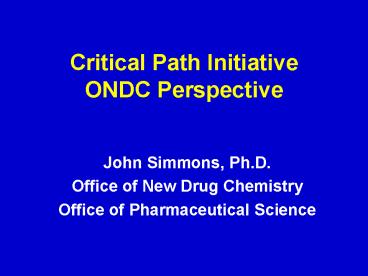Critical Path Initiative ONDC Perspective - PowerPoint PPT Presentation
1 / 22
Title:
Critical Path Initiative ONDC Perspective
Description:
Conjugated Estrogens full characterization to establish criteria for ... of in vitro Cs binding as an efficacy surrogate; free Cyanide safety issue ... – PowerPoint PPT presentation
Number of Views:28
Avg rating:3.0/5.0
Title: Critical Path Initiative ONDC Perspective
1
Critical Path InitiativeONDC Perspective
- John Simmons, Ph.D.
- Office of New Drug Chemistry
- Office of Pharmaceutical Science
2
Outline
- Critical Path Initiative
- Current Regulatory Research
- Risk Based Initiatives
- Future Programs
3
Critical Path Components
4
Critical Path Components
5
Critical Path Development
6
Current ONDC Research
- Inefficient
- Reactive
- Unfocused
- Currently Developing New Paradigms Office
Reorganization Review focus Research
focus - Seeking Input and Guidance
7
Recent Regulatory Research Activities
- Conjugated Estrogens full characterization
to establish criteria for pharmaceutical
equivalence - Prussian Blue establish the efficiency
of in vitro Cs binding as an efficacy surrogate
free Cyanide safety issue - Inhalation Products develop in vitro
methods to establish pharmaceutical equivalence
- particle size, spray pattern, chemical imaging - Drug Eluting Stents joint center
guidance shortened critical path
8
Conjugated Estrogens LC-ESI-MS Total Ion
Chromatogram
9
m/z 349
estrone-3-sulfate
17a-dihydroequilin-3-sulfate
17ß-dihydroequilin-3-sulfate
10
m/z 351
17a-estradiol-3-sulfate
17ß-estradiol-3-sulfate
11
12
13
Plume Image
14
(No Transcript)
15
Risk-Based CMC Review
- Benefits of a Risk-Based System
- Patients
- Increased availability
- Faster approval of new products
- Continued supply of quality products
- FDA
- More product and process knowledge shared by
industry - More efficient resource allocation for review and
inspection - Increased trust and understanding in decision
making
16
Risk-Based CMC Review
- Benefits of a Risk-Based System
- Industry
- More efficient, science-based inspections
resulting in increased consistency and process
understanding - Faster, more consistent reviews
- Potential for reduced regulatory burden
- Manage changes and nonconformance with less FDA
oversight - Focuses resources on critical issues
- Flexibility to focus on what should be done, not
what can be done - Improves communication with FDA
17
Pharmaceutical QualityThe New Paradigm (JW)
- Need to examine and evaluate linkages between
- Quality attributes and clinical performance?
- Values/specifications and safety effectiveness?
- cGMP compliance and safety efficacy?
- Ultimate Goal The availability to the patient of
high quality safe and effective drugs at
reasonable cost
18
The New Quality Assessment Paradigm
- CMC specifications to be based on
- Risk-based assessment
- Clinical Relevance
- Safety Considerations
- Process Capabilities
- Knowledge gained from Pharmaceutical Development
Reports - Better utilization of modern statistical
methodologies - Assessment starts with a comprehensive Quality
Overall Summary (QOS) - Review practices based on good scientific
principles (cGSP) - Increased emphasis on manufacturing science
- Peer/critical review of CMC evaluation by FDA
scientists - Integration of review and inspection
19
Benefits of New Quality Assessment Paradigm
Less regulatory oversight for post-approval
changes
More incentive for continuous product improvement
Reengineered supplement review
More resources for new NDA review
Streamlined CMC review of resubmissions
Better and less expensive drugs to patients sooner
First cycle approval of new drugs
Risk-based quality assessment
QbD and PDR by applicant
Effective communication between FDA and applicant
Comprehensive QOS by applicant
Less review time
20
Regulatory Future
- CMC only meetings with industry
- Quality by Design initiatives
- IND Guidances quality sections quality
- safety linkage - Process Analytical Technologies (PAT)
- Integration of Review-Inspection
- Strategies to facilitate 1st cycle approvals
- Combination Products
- Nano-particle drug products
21
Next Steps
- Regulatory Issues PAT Guidance
implementation CMC Guidance Revisions Combina
tion Product Guidances Review-Inspection
Integration
22
Future Goals
- Establish a meaningful regulatory science program
to support drug development and review - Explore regulatory mechanisms to speed product
approval































